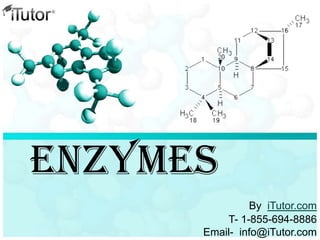Enzymes
- 2. What is an enzyme?
A biological catalyst that promotes and speeds up
a chemical reaction without itself being altered in
the process.
Lowers the activation energies of a substance
© iTutor. 2000-2013. All Rights Reserved
- 3. Properties of enzymes
1) Enzymes are proteins, thus activity easily affected by
temperature & pH.
2) Enzymes increases the rate of reaction by lowering the
activation energy barrier, thus allowing reactions to proceed
without an input of energy.
3) Mechanism: forms enzyme-substrate complex to facilitate their
interaction and reaction.
© iTutor. 2000-2013. All Rights Reserved
4) An enzyme only changes the rate at which equilibrium is
reached; it does not affect the position of the equilibrium.
5) A small quantity of the enzyme is needed for the reaction
because they are unchanged at the end of the reaction.
6) Enzymes catalyze reactions which are specify to themselves.
- 4. Structure of Enzymes
Enzymes are Proteins that:
Increase the rate of reaction by lowering the energy of activation.
Catalyze nearly all the chemical reaction taking place in the cells
of the body.
Have a unique three dimensional shapes that fit the shapes of
reactants.
© iTutor. 2000-2013. All Rights Reserved
Increasing the temperature make molecules move faster.
Biological systems are very sensitive to temperature changes.
Enzymes can increase the rate of reactions without increasing
the temperature.
They do this by lowering the activation energy.
They create a new reaction pathway “a short cut”
- 5. An enzyme controlled
pathway
Enzyme controlled reactions proceed 108 to 1011 times faster than
corresponding non- enzymic reactions.
© iTutor. 2000-2013. All Rights Reserved
- 6. Specificity
All enzymes operate only on specific substrate:
some enzymes will act only on one particular substrate;
others act on similar molecules;
many will break a particular linkage, e.g. hydrogen bonds
Properties of enzymes
© iTutor. 2000-2013. All Rights Reserved
Reversibility
Enzymes do not alter the equilibrium of a reaction but the
speed at which it is reached, e.g. carbonic anhydrase
CO2 + H2O ———— H2CO3
————
carbonic
anhydrase
- 8. Substrate concentration: Enzymic
reactions
Faster reaction but it reaches a saturation point when all the enzyme
molecules are occupied.
If you alter the concentration of the enzyme then Vmax will change
too.
Reaction
velocity
Substrate concentration
Vmax
© iTutor. 2000-2013. All Rights Reserved
- 9. The effect of pH
Optimum pH values
Enzyme
activity Trypsin
Pepsin
pH
1 3 5 7 9 11
© iTutor. 2000-2013. All Rights Reserved
- 10. The effect of pH
Extreme pH levels will produce denaturation.
The structure of the enzyme is changed
The active site is distorted and the substrate molecules will no
longer fit in it
At pH values slightly different from the enzyme’s optimum
value, small changes in the charges of the enzyme and it’s
substrate molecules will occur
This change in ionisation will affect the binding of the
substrate with the active site.
© iTutor. 2000-2013. All Rights Reserved
- 11. The effect of temperature
For most enzymes the
optimum temperature is about
30°C
Many are a lot lower; cold
water fish will die at 30°C
because their enzymes
denature
A few bacteria have enzymes
that can withstand very high
temperatures up to 100°C
Most enzymes however are
fully denatured at 70°C
© iTutor. 2000-2013. All Rights Reserved
Temperature / °C
Enzyme
activity
0 10 20 30 40 50
Temperature
coefficient
Denaturation
- 12. Irreversible inhibitors: Combine with the functional groups of the
amino acids in the active site, irreversibly.
Examples: nerve gases and pesticides, containing organ
phosphorus, combine with serine residues in the enzyme
acetylcholine esterase.
© iTutor. 2000-2013. All Rights Reserved
The effect of enzyme inhibition
Reversible inhibitors: These can be washed out of the
solution of enzyme by dialysis.
There are two categories.
Competitive:
These compete with the substrate molecules for the active
site.
The inhibitor’s action is proportional to its concentration.
Resembles the substrate’s structure closely.
- 13. Succinate Fumarate + 2H++ 2e-
Succinate dehydrogenase
CH2COOH
CH2COOH CHCOOH
CHCOOH
COOH
COOH
CH2
Malonate
© iTutor. 2000-2013. All Rights Reserved
Non-competitive: These are not influenced by the concentration of the
substrate. It inhibits by binding irreversibly to the enzyme but not at the
active site.
Examples :
Cyanide combines with the Iron in the enzymes cytochrome oxidase.
Heavy metals, Ag or Hg, combine with –SH groups.
These can be removed by using a chelating agent such as EDTA.
- 14. Enzymatic Reactions
Enzyme combines with a specific substrate to a form an
enzyme-substrate complex in a lock and key concept
before forming new products.
© iTutor. 2000-2013. All Rights Reserved
enzyme
substrate
products
- 15. Applications in food industry
Carbohydrases: Production of corn syrups from starch (glucoamylase);
conversion of cereal starches into fermentable sugars in
malting, brewing, distillery, baking industry (amylase).
Proteases: Meat tenderizers (bromelin, papain, ficin)
Lipases: Flavor production in chocolate and cheese
Glucose Oxidase: Desugaring of eggs, flour and potatoes; preparation of
salad dressings.
Pectinases: Clarification of fruit juices; increase of yield of juice from grapes
and other products; removal of excess pectin from juices before
concentration.
Lipoxygenase: Bleaching of flours.
Phosphatase: Quality testing of food products.
Phenol oxidase: Imparts the characteristic. dark hue to tea, cocoa, coffee
and raisins.
Renin (chymosin): Cheese production.
© iTutor. 2000-2013. All Rights Reserved
